 W
WThe butterfly sword is a short dao, or single-edged sword, originally from southern China, though it has also seen use in the north. It is thought that butterfly swords date from the early 19th century. Several English language accounts from the 1840s describe local militia in Guangdong being trained in the "double swords", short swords with a hook extending from the guard, and fitting into a single scabbard.
 W
WThe chain whip is a weapon used in some Chinese martial arts, particularly traditional Chinese disciplines, in addition to modern and traditional wushu. It consists of several metal rods, which are joined end-to-end by rings to form a flexible chain. Generally, the whip has a handle at one end and a metal dart, used for slashing or piercing an opponent, at the other. A cloth flag is often attached at or near the dart end of the whip and a second flag may cover the whip's handle. The flag or flags adds visual appeal and produces a rushing sound as the whip swings through the air. The rushing noise also helps the user with identifying the location of the other end, since the weapon moves too fast to be normally noticed by human eyes.
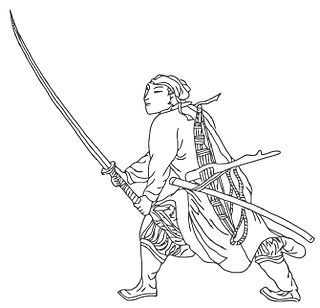 W
WThe changdao was a two-handed, single-edged Chinese sword. The term changdao has been translated as "long saber," "saber-staff," or "long-handled saber." During the Ming dynasty, changdao was often used as a general term for two handed swords. In recent discussions, the term miaodao is sometimes used to describe similar swords. Tang dynasty sources describe the changdao as being identical to the modao, but the modao may have been a double edged weapon unlike the changdao.
 W
WThe che dian chong is a breech-loading, cartridge-using musket invented by Zhao Shizhen (趙士禎) during the Ming dynasty for the dynasty's arsenals. Like all early breech loading fireams, gas leakage was a limitation and danger present in the weapon's mechanism.
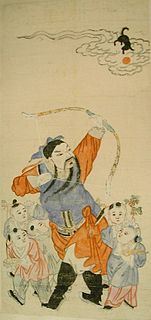 W
WFor millennia, Chinese archery has played a pivotal role in Chinese society. In particular, archery featured prominently in ancient Chinese culture and philosophy: archery was one of the Six Noble Arts of the Zhou dynasty ; archery skill was a virtue for Chinese emperors; Confucius himself was an archery teacher; and Lie Zi was an avid archer. Because the cultures associated with Chinese society spanned a wide geography and time range, the techniques and equipment associated with Chinese archery are diverse. The improvement of firearms and other circumstances of 20th century China led to the demise of archery as a military and ritual practice, and for much of the 20th century only one traditional bow and arrow workshop remained. However, in the beginning of the 21st century, there has been revival in interest among craftsmen looking to construct bows and arrows, as well as practice technique in the traditional Chinese style.
 W
WThe three most common types of Chinese polearms are the ge (戈), qiang (槍), and ji (戟). They are translated into English as dagger-axe, spear, and halberd. Dagger-axes were originally a short slashing weapon with a 0.9 to 1.8 m long shaft, but around the 4th century BC a spearhead was added to the blade, and it became a halberd. The spear is also sometimes called a mao (矛), which is sometimes used to designate polearms with a wavy snake-like spearhead. There was another polearm weapon known as the pi (鈹), translated into English as either sword-staff or long lance, that was used from ancient times until the Han dynasty. It was essentially a short sword attached to a stick. From the Warring States period onward, the length of Chinese polearms varied from around 2.8 m to 5.5 m, however there is no specific designation for a pike in the traditional Chinese lexicon. A very long spear is just called a long spear.
 W
WHistorically, all Chinese swords are classified into two types, jian and dao. Jians are double-edged straight swords while daos are single-edged, and mostly curved from the Song dynasty forward. The jian has been translated at times as a long sword, and the dao a saber or a knife. Bronze jians appeared during the mid-third century BC and switched to wrought iron and steel during the late Warring States period. Other than specialized weapons like the Divided Dao, Chinese swords are usually 70–110 cm (28–43 in) in length, although longer swords have been found on occasion. Outside of China, Chinese swords were also used in Japan from the third to the sixth century AD, but were replaced with Korean and native Japanese swords by the middle Heian era.
 W
WA crossbow is a ranged weapon using an elastic launching device similar to a bow; it consists of a bow-like assembly called a prod, mounted horizontally on a main frame called a tiller, which is hand-held in a similar fashion to the stock of a long gun. Crossbows shoot arrow-like projectiles called bolts or quarrels. A person who shoots crossbow is called a crossbowman or an arbalist.
 W
WThe dagger-axe is a type of pole weapon that was in use from the Shang dynasty until the Han dynasty in China. It consists of a dagger-shaped blade, mounted by its tang to a perpendicular wooden shaft. The earliest dagger-axe blades were made of stone. Later versions used bronze. Jade versions were also made for ceremonial use. There is a variant type with a divided two-part head, consisting of the usual straight blade and a scythe-like blade.
 W
WDao are single-edged Chinese swords, primarily used for slashing and chopping. The most common form is also known as the Chinese sabre, although those with wider blades are sometimes referred to as Chinese broadswords. In China, the dao is considered one of the four traditional weapons, along with the gun, qiang (spear), and the jian.
 W
WDeer horn knives, also known as crescent moon knives or duck blades, are specialised Chinese bladed weapons consisting of two steel crescents crossing. They are used in Chinese martial arts. This crossing produces four curved, clawlike points, one of which is extended as the "main" blade. The practitioner grips the wrapped middle of the lengthened crescent with the other acting as a hand guard. They are relatively short weapons that are easily concealable in traditional Chinese clothing, and are usually trained in pairs, one for each hand.
 W
WEmeici are a traditional Chinese martial arts weapon. They are a pair of metal rods with sharp ends used for stabbing; they are typically mounted on a detachable ring worn on the middle finger, allowing them to spin and be elaborately manipulated.
 W
WThe Fierce-fire Oil Cabinet was a double-piston pump naphtha flamethrower first recorded to have been used in 919 AD in China, during the Five Dynasties and Ten Kingdoms period.
 W
WThe fire lance was a very early gunpowder weapon that appeared in 10th-century China and was used to great effect during the Jin-Song Wars. It began as a small pyrotechnic device attached to a spear-like weapon, used to gain a critical shock advantage right at the start of a melee. As gunpowder improved, the explosive discharge was increased, and debris or pellets added, giving it some of the effects of a combination modern flamethrower and shotgun, but with a very short range, and only one shot. In later larger and more powerful fire lances, the lance-point was discarded, as these versions were too unwieldy to be used in melee. These are considered to be a proto-gun, the predecessor of the hand cannon, and the ancestor of all firearms. Some fire lances were too large for a single man to wield. These were placed upon the ground in a supporting framework, and can be considered proto-cannons.
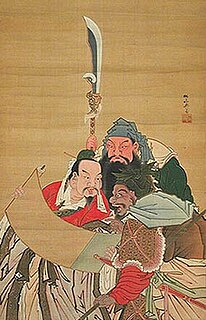 W
WA guandao is a type of Chinese pole weapon that is used in some forms of Chinese martial arts. In Chinese, it is properly called a yanyuedao, the name under which it always appears in texts from the Song to Qing dynasties such as the Wujing Zongyao and Huangchao Liqi Tushi. It is comparable to the Japanese naginata and the European fauchard or glaive and consists of a heavy blade with a spike at the back and sometimes also a notch at the spike's upper base that can catch an opponent's weapon. In addition there are often irregular serrations that lead the back edge of the blade to the spike. The blade is mounted atop a 1.5 m to 1.8 m (5–6 foot) long wooden or metal pole with a pointed metal counter weight used to balance the heavy blade and for striking on the opposite end.
 W
WA gun is a long Chinese staff weapon used in Chinese martial arts. It is known as one of the four major weapons, along with the qiang (spear), dao (sabre), and the jian. It is called, in this group, "The Grandfather of all Weapons". In Vietnam, the gun is known as Côn in Vietnamese martial arts.
 W
WThe Ming dynasty continued to improve on gunpowder weapons from the Yuan and Song dynasties. During the early Ming period larger and more cannons were used in warfare. In the early 16th century Turkish and Portuguese breech-loading swivel guns and matchlock firearms were incorporated into the Ming arsenal. In the 17th century Dutch culverin were incorporated as well and became known as hongyipao. At the very end of the Ming dynasty, around 1642, Chinese combined European cannon designs with indigenous casting methods to create composite metal cannons that exemplified the best attributes of both iron and bronze cannons. While firearms never completely displaced the bow and arrow, by the end of the 16th century more firearms than bows were being ordered for production by the government, and no crossbows were mentioned at all.
 W
WThe Heilongjiang hand cannon or hand-gun is a bronze hand cannon manufactured no later than 1288 and is the world's oldest confirmed surviving firearm. It weighs 3.55 kg and is 34 centimeters long. The Heilongjiang hand cannon was excavated during the 1970s in Banlachengzi, a village in Acheng District, Heilongjiang province, China. It was found alongside other bronze artifacts made in the style of the Jurchen Jin Dynasty. The hand cannon was probably used in battles fought nearby Banlachengzi in 1287 and 1288. The History of Yuan states that a Jurchen commander by the name of Li Ting led a group of soldiers equipped with hand cannons into a military camp in 1288, as part of an anti-rebellion campaign for the Yuan dynasty. The cannon currently resides at the Heilongjiang Provincial Museum in Harbin, China.
 W
WThe hook sword, twin hooks, fu tao, hu tou gou or shuang gou is a Chinese weapon traditionally associated with northern styles of Chinese martial arts and Wushu weapons routines, but now often practiced by southern styles as well.
 W
WHuochong was the Chinese name for hand cannons. The oldest confirmed metal huochong, also the first cannon, is a bronze hand cannon bearing an inscription dating it to 1298.
 W
WThe Huolongjing, also known as Huoqitu, is a 14th-century military treatise compiled and edited by Jiao Yu and Liu Bowen of the early Ming dynasty (1368–1683). The Huolongjing is primarily based on the text known as Huolong Shenqi Tufa, which is no longer extant.
 W
WThe jian is a double-edged straight sword used during the last 2,500 years in China. The first Chinese sources that mention the jian date to the 7th century, during the Spring and Autumn period; one of the earliest specimens being the Sword of Goujian. Historical one-handed versions have blades varying from 45 to 80 centimeters in length. The weight of an average sword of 70-centimetre (28-inch) blade-length would be in a range of approximately 700 to 900 grams. There are also larger two-handed versions used for training by many styles of Chinese martial arts.
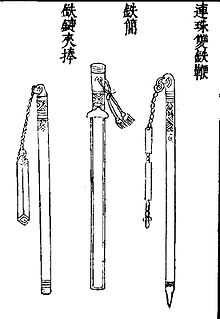 W
WThe Jiǎn or Tie Jian, also known as Chinese swordbreaker, is a type of quad-edged straight mace or club specifically designed to break weapons with sharp edges. The traditional Chinese weapon has a rectangular cross section with sharp corners, making it ideal to focus on damaging other weapons with brutal impact. It also ends with a tip.
 W
WThe Jixiao Xinshu or New Treatise on Military Efficiency is a military manual written during the 1560s and 1580s by the Ming dynasty general Qi Jiguang. Its primary significance is in advocating for a combined arms approach to warfare using five types of infantry and two type of support. Qi Jiguang separated infantry into five separate categories: firearms, swordsmen, archers with fire arrows, ordinary archers, and spearmen. He split support crews into horse archers and artillery units. The Jixiao Xinshu is also one of the earliest existing East Asian texts to address the relevance of Chinese martial arts with respect to military training and warfare. Several contemporary martial arts styles of Qi's era are mentioned in the book, including the staff method of the Shaolin temple.
 W
WThe liuyedao or willow-leaf saber is a type of dao that was commonly used as a military sidearm for both cavalry and infantry during the Ming and Qing dynasties. A descendent of the earlier Mongol saber the liuyedao remained the most popular type of single handed sabre during the Ming Dynasty, replacing the role of the military role of the Jian. Many schools of Chinese martial arts originally trained with this weapon.
 W
WThe Manchu bow is a type of composite recurve bow historically used in Manchuria, and subsequently spread to China, Mongolia, and Tibet during the Qing dynasty. It is similar in construction and likely shares roots with the medieval Mongol bow. It is characterized by very large siyahs, long draw length, prominent string bridges, and use with typically large and heavy arrows. Due to its extensive usage outside Manchuria, this bow is also often identified as a Chinese bow or Mongol bow, and during the 17th century, its widespread usage almost completely displaced all other types of bows in the Qing Empire.
 W
WMeng Huo You is the name given to petroleum in ancient China, which practiced the use of petroleum as an incendiary weapon in warfare.
 W
WThe meteor hammer, often referred to simply as meteor, is an ancient Chinese weapon, consisting at its most basic level of two weights connected by a rope or chain. One of the flexible or "soft" weapons, it is referred to by many different names worldwide, dependent upon region, construction and intended use. Other names in use include dai chui, flying hammer, or dragon's fist. It belongs to the broader classes of flail and chain weapons.
 W
WThe miaodao (苗刀) is a Chinese two-handed dao or saber of the Ming Dynasty era, with a narrow blade with a length of 1.2 metres (47 in) or more and a long hilt. The name means "sprout saber", presumably referring to a likeness between the weapon and a newly sprouted plant. Its origin is katana, presumably ōdachi, brought to China by the Japanese pirates. While the miaodao is a recent weapon, the name has come to be applied to a variety of earlier Chinese long sabers, such as the zhanmadao and changdao. Along with the dadao, miaodao were used by some Chinese troops during the Second Sino-Japanese War.
 W
WThe Nangun is a variation of the application of the "northern Chinese staff", which is featured in contemporary wushu exercises and forms. It is based on staff techniques coming from Southern Chinese martial arts. Its movements stress hitting, in contrast to the cutting and swinging techniques of the northern staff.
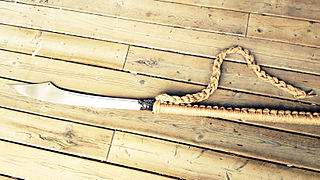 W
WPodao or pudao is a Chinese single-edged infantry weapon which is still used primarily for training in various Chinese martial arts. The blade of the weapon is shaped like a Chinese broadsword, but the weapon has a longer handle, usually around one to two meters which is circular in cross section. It looks somewhat similar to the guandao.
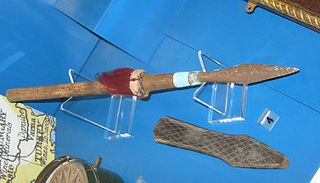 W
WQiang is the Chinese term for spear. Due to its relative ease of manufacture, the spear in many variations was ubiquitous on the pre-modern Chinese battlefield. It is known as one of the four major weapons, along with the gun (staff), dao (sabre), and the jian, called in this group "The King of Weapons".
 W
WThe repeating crossbow is a Chinese crossbow that was invented during the Warring States period, and remained in use until the late Qing dynasty. It is also known as the Zhuge crossbow due to its association with the Three Kingdoms-era strategist Zhuge Liang (181–234 AD).
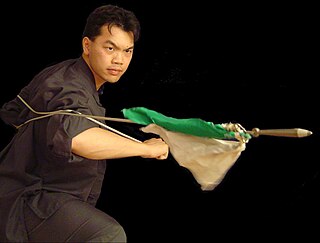 W
WThe rope dart or rope javelin, also known as Jōhyō in Japanese, is one of the flexible weapons in Chinese martial arts. Other weapons in this family include the meteor hammer, flying claws, Fei Tou flying weight, and chain whip. Although the flexible weapons share similar movements, each weapon has its own specific techniques.
 W
WThe three-section staff, triple staff, three-part staff, sansetsukon in Japanese, or originally sanjiegun, is a Chinese flail weapon that consists of three wooden or metal staffs connected by metal rings or rope. The weapon is also known as 蟠龍棍 panlong gun, "coiling dragon staff". A more complicated version of the two section staff, the staves can be spun to gather momentum resulting in a powerful strike, or their articulation can be used to strike over or around a shield or other defense.
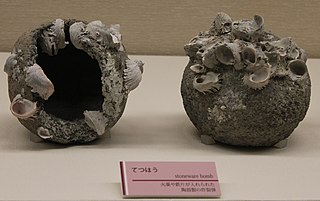 W
WThe thunder crash bomb is an early type of bomb or hand grenade developed in the 12th-13th century Song and Jin-era China. Its shell was made of cast iron and filled with gunpowder. The length of the fuse could be adjusted according to the intended throwing distance.
 W
WThe wall gun or wall piece was a type of smoothbore firearm used in the 16th through 18th centuries by defending forces to break the advance of enemy troops. Essentially, it was a scaled-up version of the army's standard infantry musket, operating under the same principles, but with a bore of up to one-inch (25.4 mm) calibre. These weapons filled a gap in firepower between the musket and the lightest artillery pieces, such as the swivel gun. This sort of weapon may also be found described as an amusette, rampart gun or Hackbut, a name originally given to early medieval hand cannon.
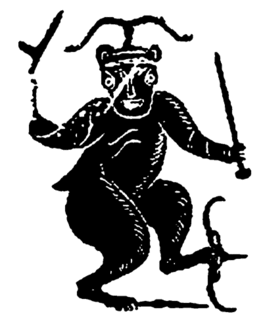 W
WLegendary weapons, arms, and armor are important motifs in Chinese mythology as well as Chinese legend, cultural symbology, and fiction. Weapons featured in Chinese mythology, legend, cultural symbology, and fiction include Guanyu's pole weapon. This non-factually documented weapon has been known as the Green Dragon Crescent Blade. Other weapons from Chinese mythology, legend, cultural symbology, and fiction include the shield and battleax of the defiant dancer Xingtian, Yi's bow and arrows, given him by Di Jun, and the many weapons and armor of Chiyou, who is associated with the elemental power of metal. Chinese mythology, legend, cultural symbology, and fiction features the use of elemental weapons such as ones evoking the powers of wind and rain to influence battle.
 W
WWind-and-fire wheels are mêlée weapons, wielded as a pair, associated with Chinese martial arts such as baguazhang and taijiquan. Visually, they are similar to chakrams, although unlike chakrams they are not throwing weapons.
 W
WThe Wubei Zhi, also commonly known by its Japanese translated name Bubishi, is the most comprehensive military book in Chinese history. It was compiled in 1621 by Mao Yuanyi, an officer of waterborne troops in the Ming Dynasty. The Wubei Zhi contains 240 volumes, 10405 pages, and more than 200,000 Chinese characters, which makes it the longest book in Chinese history regarding military affairs.
 W
WThe Wujing Zongyao, sometimes rendered in English as the Complete Essentials for the Military Classics, is a Chinese military compendium written from around 1040 to 1044.
 W
WThe Wuwei Bronze Cannon or Xi Xia Bronze cannon was discovered in 1980 and is probably the oldest and largest cannon dated to the 13th century. This 100 centimeter long, 108 kilogram bronze cannon was discovered in a cellar in Wuwei, Gansu Province. It bears no inscription, but has been dated by historians to the late Western Xia period between 1214 and 1227 through contextual evidence. The gun contained an iron ball about nine centimeters in diameter, which is smaller than the muzzle diameter at twelve centimeters, and 0.1 kilograms of gunpowder in it when discovered, meaning that the projectile might have been another co-viative. Ben Sinvany and Dang Shoushan believe that the ball used to be much larger prior to its highly corroded state at the time of discovery. While large in size, the weapon is noticeably more primitive than later Yuan dynasty guns such as the Xanadu Gun and Heilongjiang hand cannon, and is unevenly cast. A similar weapon was discovered not far from the discovery site in 1997, but is much smaller in size at only 1.5 kg.
 W
WThe oldest extant gun bearing a date of production is the Xanadu Gun, so called because it was discovered in the ruins of Xanadu (Shangdu), the summer palace of the Yuan dynasty in Inner Mongolia, China. The Xanadu Gun is 34.7 cm in length and weighs 6.21 kg, its muzzle is flared outwards, slightly bowl-shape, and called by Chinese as 碗口铳. Its dating is based on archaeological context and a straightforward inscription containing an era name and year that correspond with the Gregorian Calendar at 1298. Not only does the inscription contain the era name and date, it also includes a serial number and manufacturing information which suggests that gun production had already become systematized, or at least become a somewhat standardized affair by the time of its fabrication. The design of the gun includes axial holes in its rear which some speculate could have been used in a mounting mechanism. Like most early guns with the possible exception of the Western Xia gun, it is small, weighing just over six kilograms and thirty-five centimeters in length. Although the Xanadu Gun is the most precisely dated gun from the 13th century, other extant samples with approximate dating may be older.
 W
WThe xun lei chong is a revolving-barrel, spear-combined musket invented by Zhao Shi-zhen (趙士禎) during the Ming dynasty.
 W
WThe zhanmadao was a single-bladed anti-cavalry Chinese sword. It originated during the Han Dynasty and was especially common in Song China (960–1279).